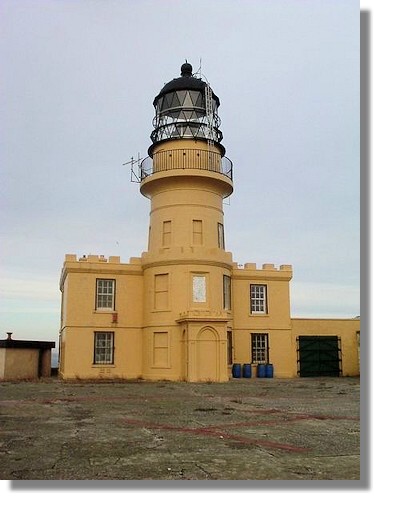

Lighthouse Beacons from Scotland
Inchkeith Lighthouse

Photo by Ronnie Leask via Wikimedia via Wikimedia
Inchkeith island lies roughly between Leith and Kinghorn and has fulfilled many roles in its long history including a Seat of Pictish Kings, a base for early Christian Evangelists, an isolation colony for the plague stricken, a medieval fortress and a site for heavy guns during two world wars. The graphic of Inchkeith shown here is via Wikimedia and was taken from Portobello on the south shore of the Firth of Forth.
The lighthouse was built in 1803 and first operated in September 1804. It is listed as a building of Architectural/Historic interest.
Vegetable Oil was first used in Britain as Lighthouse illuminant in 1736 and became more widely used by the close of the eighteenth century. Mineral oil or paraffin was discovered by James Young in 1846 and first produced commercially in the early 1850's. However, the burners then available for the consumption of vegetable oil were not suitable for use with paraffin, as they required a greater supply of air to the burner. In 1868 Captain Doty devised a mineral oil burner suitable for Lighthouse use. The advantage of mineral oil was for equal rate consumption of fuel, the cost was halved and the luminous intensity increased.
The original fixed light gave way to a revolving beacon in 1815 and in 1835 the first dioptric lantern used in Scotland was installed - a fixed burner revolving round a heptagon. Later an octagonal optic of lenses rotated around an incandescent paraffin lamp, producing a beam of 167,000 candlepower which could be seen in clear visibility for 21 miles. Paraffin oil under pressure forced up a centre column provided the fuel for the light. Near the special mantle it was vaporised and the 55mm burner sent out a light. (The graphic of Inchkeith on the left via Wikimedia is by Stewart Glasson).
The lens was made up of 8 sections and as the light lined up with each the flash was sent out. Prisms close together but not connected, sent it out horizontally over the water. Surrounding all this were long panes of glass which had to be spotless every evening. During good weather the prisms and mantle were protected by blinds because the sun glinting through the glass and on to the prisms could have had a burning effect.
A fog signal on Inchkeith was established in 1899. It consisted of a horn operated by compressed air giving two blasts of 3.5 seconds duration every 90 seconds. In 1958 a further development took place. A diaphone Fog Signal giving 4 blasts each of 1.5 seconds duration in quick succession every 60 seconds was established on an experimental basis on Inchcolm. It was remotely controlled by radio telephone from Inchkeith Lighthouse. This was replaced with an electrically operated system controlled by an automatic fog detector in 1986. (The graphic on the right is by James Allan, via Wikimedia.
The lighthouse was automated in 1986 and the Lightkeepers withdrawn. The present light is an array of lamps, similar to car headlamps which flashes white every 15 seconds for a range of 22 miles, and rotated on a gearless pedestal which only requires a low voltage supply.
The system is powered by banks of nickel cadmium batteries charged on a time cycle of three times per week by one of two alternators with diesel engines.
Return to Index of Lighthouse Beacons from Scotland



